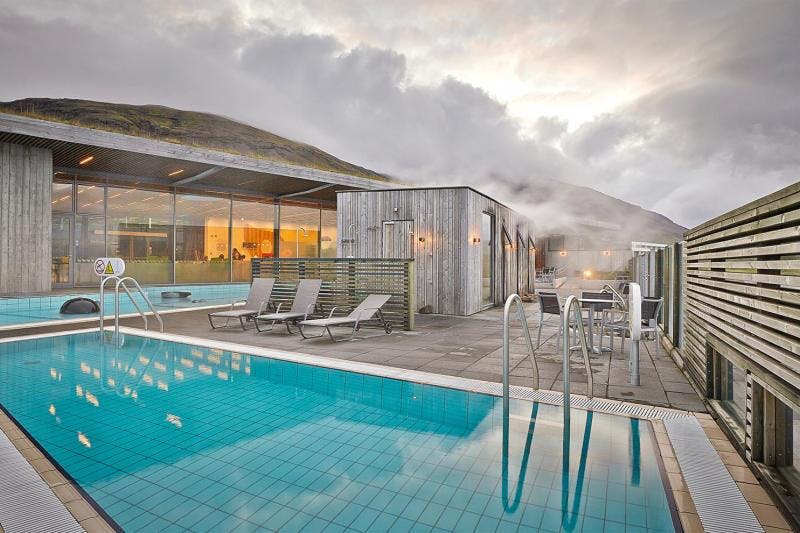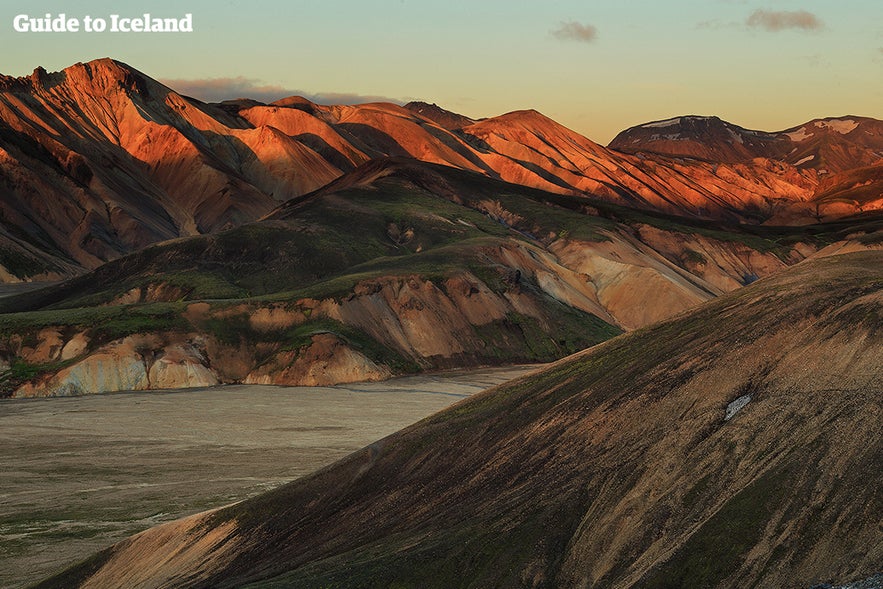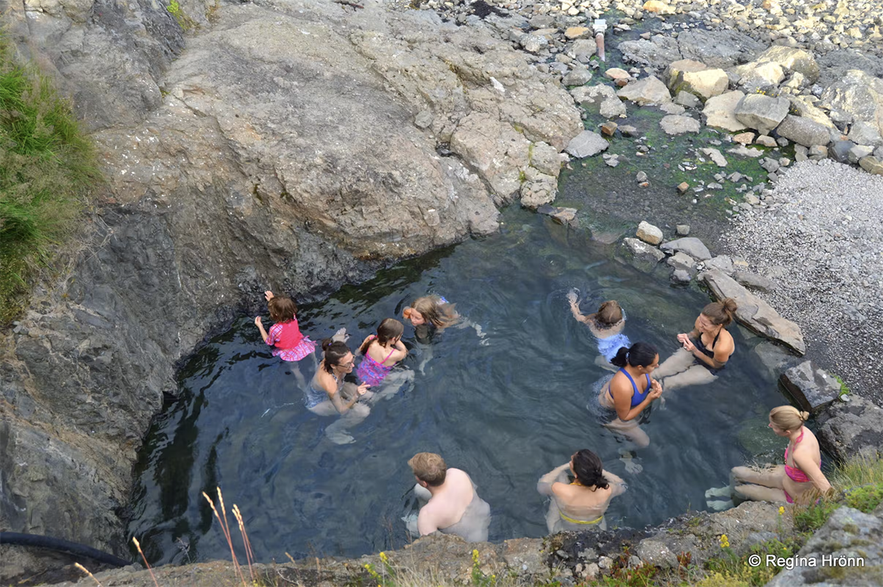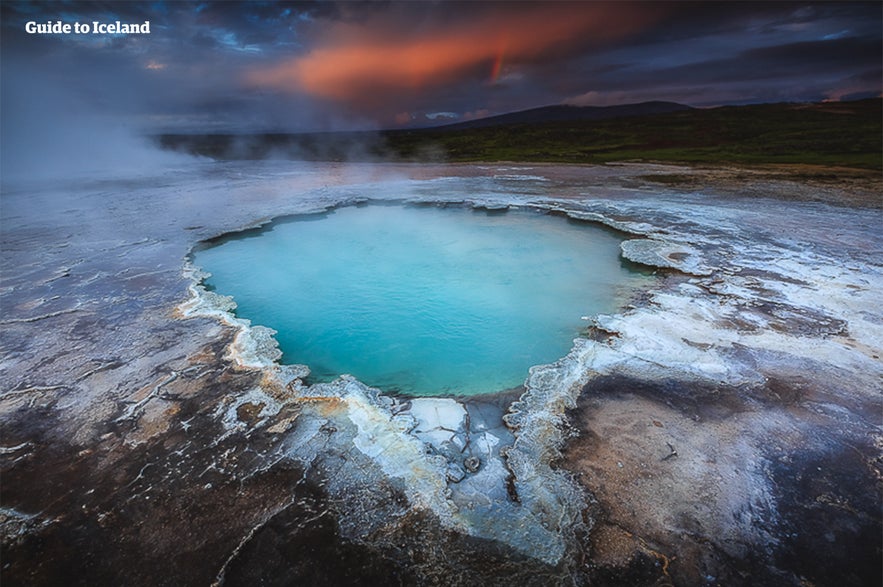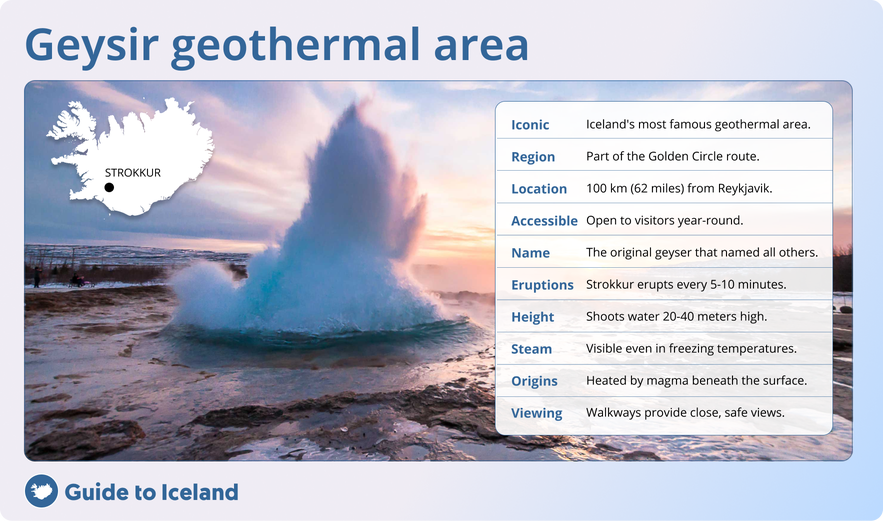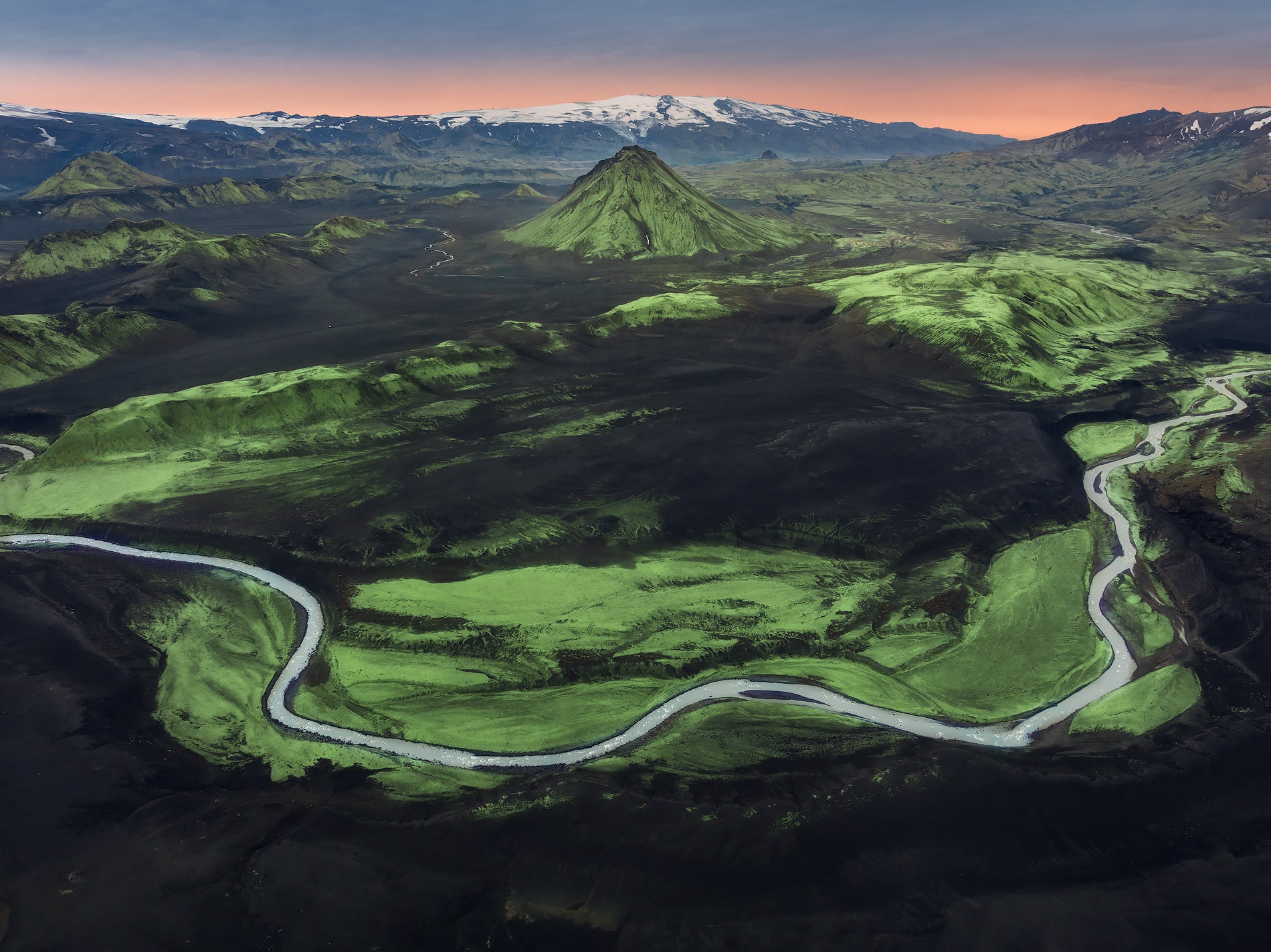Discover the best hot springs and geothermal pools in Iceland, from luxurious hot spring spas like Blue Lagoon to hidden natural hot springs and cozy hot tubs. This guide highlights Iceland’s best geothermal spots and which ones you can safely soak in or admire.
Often called the “land of fire and ice,” Iceland is shaped by glaciers, geothermal heat, and countless natural hot springs. Those eager to experience this geothermal magic can join hot spring tours in Iceland or visit and relax at the Blue Lagoon.
Why You Can Trust Our Content
Guide to Iceland is the most trusted travel platform in Iceland, helping millions of visitors each year. All our content is written and reviewed by local experts who are deeply familiar with Iceland. You can count on us for accurate, up-to-date, and trustworthy travel advice.
To experience it all your way, you can easily rent a vehicle and explore many hot springs and geothermal pools at your own pace. As you travel from region to region, find the best places to stay in Iceland for a comfortable and memorable adventure.
Soaking in a hot spring is a classic Icelandic experience. Whether it’s a natural pool tucked away in the countryside or a modern spa with all the comforts, the best geothermal spas in Iceland offer a relaxing way to connect with nature.
Read on to discover the top 10 lagoons in Iceland, the best 5 geothermal pools, the ultimate 5 hot tubs, and the top 5 natural hot springs, plus which hot springs you shouldn’t bathe in and why.
Things To Know Before You Go
-
Lagoons: Large, developed geothermal baths that combine relaxation with spa facilities.
-
Geothermal Pools: Man-made bathing areas that use naturally heated water sourced from underground hot springs.
-
Hot Tubs: Smaller pools or tubs filled with geothermal water, usually located near hotels, cabins, or along the coast.
-
Hot Springs: Naturally heated pools formed by geothermal activity, often found outdoors in untouched nature.
-
Safety First: Not all hot springs are safe to bathe in; some have scalding temperatures or unstable edges. Always check before entering.
-
Best Way To Explore: Self-drive tours in Iceland give you the freedom to visit hidden geothermal gems at your own pace.
-
Bring Essentials: Pack swimwear, a quick-dry towel, flip-flops, and plenty of water to stay hydrated during your hot spring visits. For more tips, check out this guide on what to pack for Iceland.
Why Experiencing a Hot Spring in Iceland Is a Must
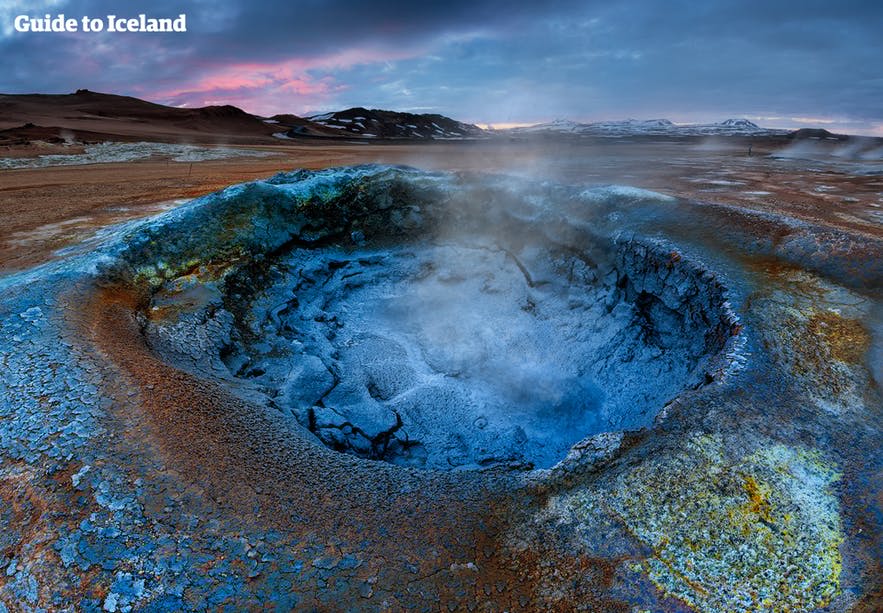
That’s why the best hot springs and geothermal pools in Iceland are more than scenic stops. They’re living examples of nature’s power and balance.
These spots remain a cornerstone of Icelandic life—a place to unwind, socialize, and embrace the country’s geothermal heart. Even in Reykjavik, most neighborhoods have nearby heated swimming pools, providing a daily reminder of how close nature always is.
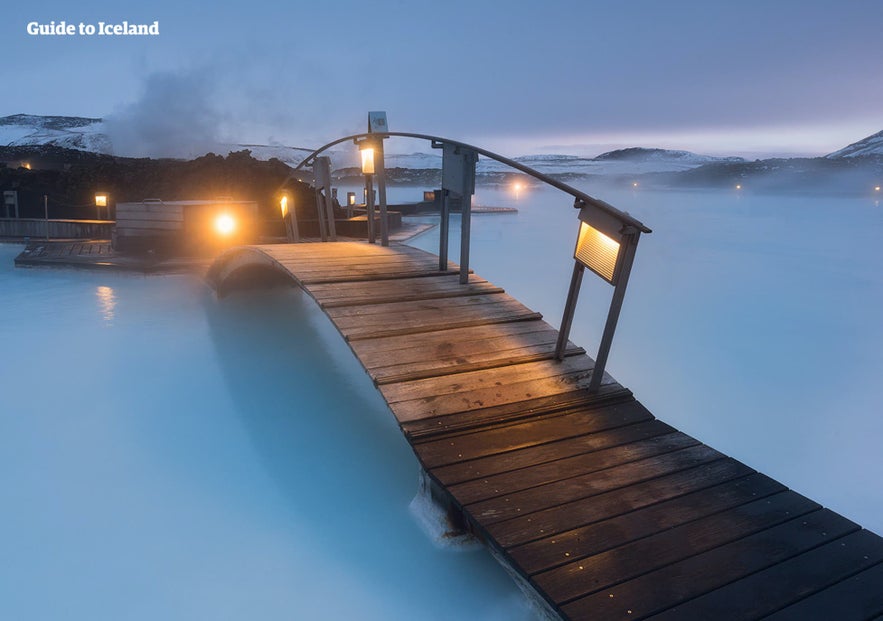 What makes it a must for travelers is the variety of experiences: hiking to remote hot springs like Reykjadalur or Landbrotalaug, soaking in natural pools beneath the northern lights, or visiting world-class spas built right into the volcanic landscape.
What makes it a must for travelers is the variety of experiences: hiking to remote hot springs like Reykjadalur or Landbrotalaug, soaking in natural pools beneath the northern lights, or visiting world-class spas built right into the volcanic landscape.
Each soak feels uniquely Icelandic, both invigorating and grounding at the same time. Whether you go for adventure, wellness, or simple wonder, bathing in Iceland’s hot springs is an unforgettable way to feel the island’s natural rhythm.
Top 10 Hot Spring Spas and Lagoons in Iceland
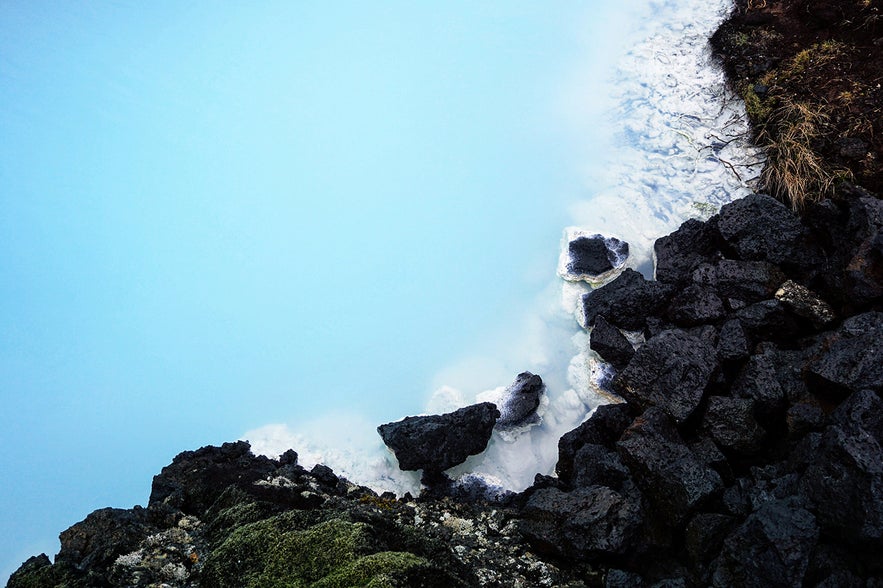
Many of Iceland's natural hot springs are free to enter, but since they’re located out in the countryside under the open sky, they don’t offer changing rooms, showers, or bathrooms.
Because of this, several other hot springs and pools charge an entrance fee but provide excellent facilities in return. These have become some of the most popular hot springs in Iceland. Many people would even classify them as spas, though each still features a natural hot spring element.
Here are the most popular hot spring spas in Iceland.
10. Krauma Spa
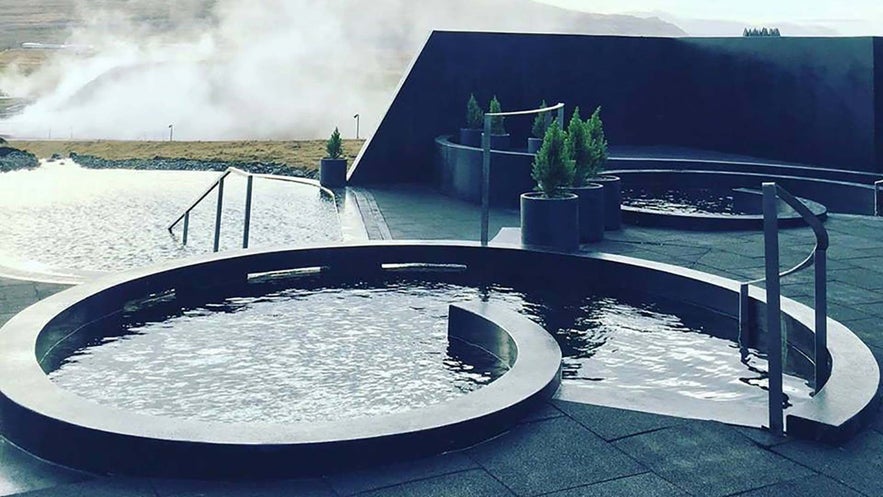
Krauma Spa opened in late 2017 and quickly became one of the most popular hot spring spas in Iceland, especially among those exploring West Iceland.
This modern geothermal spa sits beside Deildartunguhver, Europe’s most powerful hot spring, which provides the naturally hot water used in the baths. Since the spring water from Deildartunguhver is nearly boiling, it’s mixed with fresh glacial water to achieve the perfect soaking temperature.
By booking an admission ticket to Krauma Spa, you can relax in six beautiful black marble tubs that overlook the steaming hot spring or enjoy the soothing saunas on-site. Five of these tubs are warm with varying temperatures, while one is cold (41 F to 46 F / 5 C to 8 C), excellent for boosting your blood circulation.
With clean showers, changing facilities, and an on-site restaurant, Krauma Spa is undoubtedly a popular destination in West Iceland that offers one of the best geothermal spa experiences in Iceland.
9. Fontana Spa
Fontana Spa is located next to Laugarvatn Lake, about 48 miles (78 kilometers) from Reykjavik. Conveniently situated near Iceland’s most popular sightseeing route, it’s a perfect place to relax and recharge during a guided Golden Circle trip.
The Laugarvatn area sits atop an active geothermal zone, and locals have been harnessing the natural hot water for heating, cooking, and bathing since 1929.
One of the saunas at Fontana Spa is the same one used decades ago, now beautifully renovated. Built directly over a steaming hot spring, the sauna’s heat is naturally controlled. If it gets too warm, you can simply open the door to let in cool air.
For a refreshing contrast, adventurous visitors can take a dip in Laugarvatn Lake, even in winter, as parts of the lake remain warm year-round due to geothermal activity. The sand between the baths and the lake is naturally heated, and in some spots, it’s hot enough to bake traditional Icelandic rye bread underground.
You can sample this freshly baked bread at the Fontana Cafe, located right at the entrance. It’s a unique experience that makes Fontana Spa one of the best geothermal spas in Iceland to visit any time of year.
8. GeoSea Geothermal Baths
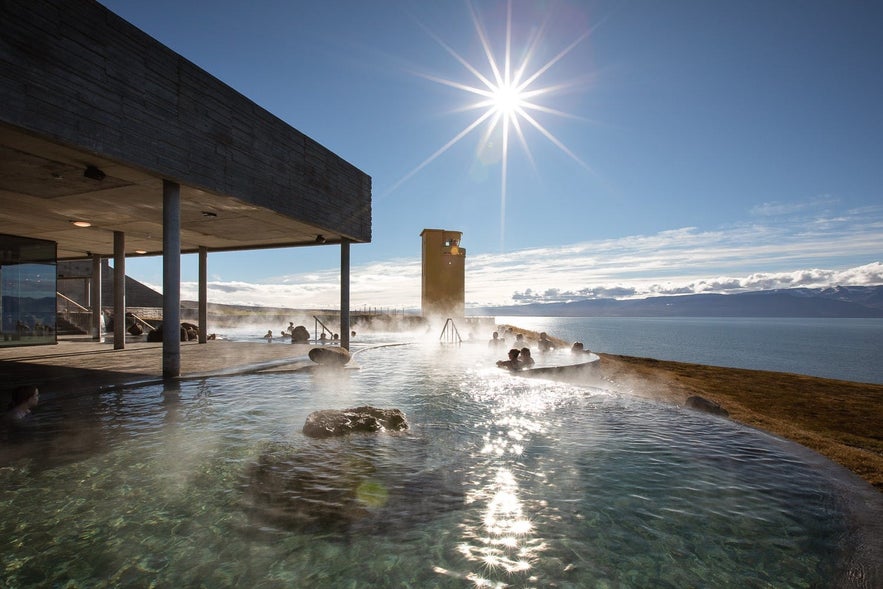
The GeoSea Geothermal Baths are one of the best hot spring spas in Iceland and a must-visit attraction in North Iceland. It’s located in the charming town of Husavik, often called the whale-watching capital of Europe.
As the name suggests, GeoSea offers something truly unique: geothermally heated seawater instead of the usual spring water. The result is a natural Iceland salt bath rich in minerals that gently exfoliate and nourish your skin.
The water is drawn from two nearby boreholes, creating a steady flow through the pools, which means no added chemicals are needed to maintain cleanliness.
With your GeoSea Geothermal Baths admission ticket, enjoy soaking in the warm, mineral-rich water while admiring the breathtaking views over Skjalfandi Bay, where you might even spot whales in the distance. The horizon stretches endlessly, framed by rugged mountains and the glistening North Atlantic Ocean.
GeoSea also features a cozy restaurant and outdoor terrace, perfect for enjoying light refreshments while taking in the sea views. Modern changing facilities make your visit smooth and comfortable from start to finish.
If you’re planning to explore Husavik, the GeoSea Geothermal Baths are a must-visit stop on any North Iceland itinerary.
7. Forest Lagoon
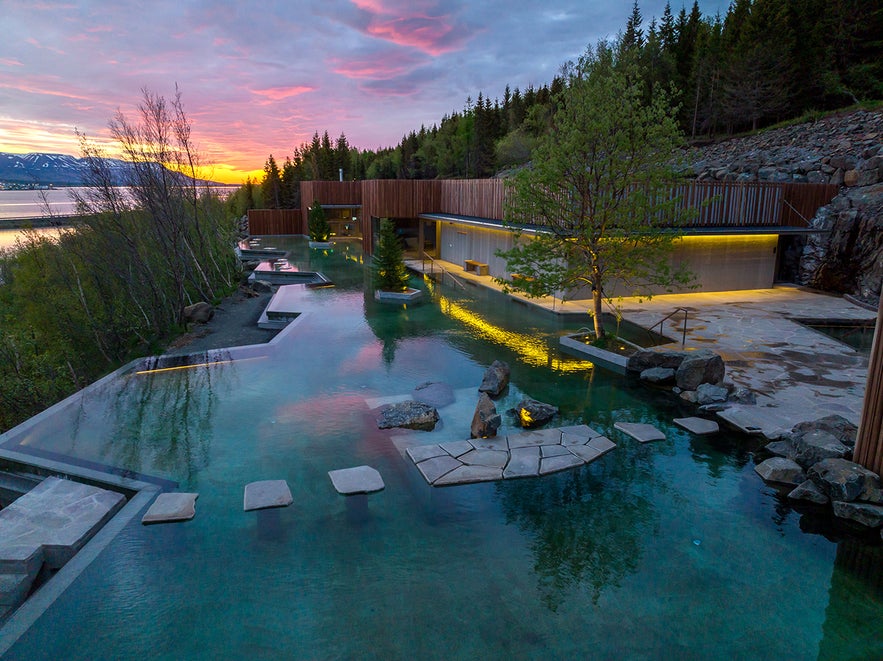 Opened in 2022, the Forest Lagoon is one of the newest and best geothermal spas in Iceland. This scenic spa in North Iceland is set within the lush forest of Vadlaskogur, surrounded by trees and rich foliage that create a peaceful, natural atmosphere.
Opened in 2022, the Forest Lagoon is one of the newest and best geothermal spas in Iceland. This scenic spa in North Iceland is set within the lush forest of Vadlaskogur, surrounded by trees and rich foliage that create a peaceful, natural atmosphere.
Wooden elements are incorporated throughout the lagoon, blending seamlessly with the landscape. The architecture firm behind Forest Lagoon is the same one that designed the Blue Lagoon, so you can expect the same type of care and attention to detail as in Iceland's most popular geothermal spa.
The two infinity pools overlook the stunning Eyjafjordur Fjord, giving you great views of Akureyri and the surrounding area. Experience two in-water bars, a sauna, a quiet room, a cold tub, and an on-site restaurant to dine at after a long, warm soak in the geothermal waters.
Forest Lagoon is also known for its long opening hours, from 10 AM until midnight, giving visitors plenty of time to unwind. You can book your Forest Lagoon admission ticket in advance to ensure a smooth and hassle-free visit to one of the best hot spring spas in Iceland.
6. Vok Baths

Geothermal heat, which is not common in East Iceland, was discovered in Lake Urridavatn when locals noticed that certain parts of the lake did not freeze over during winter. For the longest time, these spots were used for washing clothes when it was difficult to find water during Iceland's coldest period of the year.
However, in 2019, Vok Baths opened with the goal of using the geothermal source for bathing while still keeping that special connection to nature. Today, it’s recognized as one of the best hot spring spas in Iceland for its unique floating pools and tranquil lakeside views.
The spa features two floating infinity pools, an indoor pool, a steam room, an in-water bar, and a bistro that serves light courses for adults and kids. The lake’s water is exceptionally clean, offering a refreshing contrast to the warmth of the pools. Many visitors take a quick dip in the cold lake before returning to the soothing geothermal waters.
The geothermal water in eastern Iceland is unique because it's the only naturally warm drinkable water in Iceland. It runs out of the tap at 165 F (75 C) and is used to brew teas with a selection of organic and locally sourced herbs, which guests can enjoy while visiting the facility.
Book your Vok Baths admission early so you don't miss out on the experience!
5. Earth Lagoon Myvatn (Myvatn Nature Baths)
 Earth Lagoon Myvatn, previously called the Myvatn Nature Baths, took on its new name in October 2025.
Earth Lagoon Myvatn, previously called the Myvatn Nature Baths, took on its new name in October 2025.
This North Iceland gem is the region’s stunning answer to the Blue Lagoon, featuring the same silky, milky-blue geothermal waters and serene atmosphere. It’s one of the best hot spring spas in Iceland, offering an authentic and more peaceful alternative to its famous southern counterpart.
Located near Lake Myvatn, Earth Lagoon provides the same rejuvenating geothermal experience at a more affordable price. You can secure your Earth Lagoon Myvatn admission ticket in advance to guarantee entry and enjoy a smooth visit.
Though it’s about 288 miles (465 kilometers) from Reykjavik, the journey is worth it for those seeking serenity away from the crowds. It’s perfect for travelers exploring North Iceland or joining Myvatn tours to discover the region’s geothermal and volcanic wonders.
The lagoon features excellent facilities, including showers, changing rooms, a sauna, and a cafe. The surrounding Myvatn area is filled with geothermal wonders, making it easy to combine a dip at Earth Lagoon with sightseeing around the must-see destinations in North Iceland.
There are also great accommodation options in Myvatn, allowing visitors to stay overnight and fully enjoy the peaceful environment.
Note: Earth Lagoon Myvatn will temporarily close for renovations from January 1st, 2026, with a planned reopening in March or April of the same year. When it reopens, it’s expected to offer an even better and more sustainable geothermal bathing experience, solidifying its place among the top hot spring spas in Iceland.
4. Hvammsvik Hot Springs
 Just outside of Reykjavik, in the nearby fjord of Hvalfjordur, you’ll find one of the newest and most unique hot spring spas in Iceland, Hvammsvik Hot Springs. Opened in 2022, this stunning retreat was designed to blend seamlessly with nature, letting you experience the flow of the ocean tides while soaking in warm geothermal waters.
Just outside of Reykjavik, in the nearby fjord of Hvalfjordur, you’ll find one of the newest and most unique hot spring spas in Iceland, Hvammsvik Hot Springs. Opened in 2022, this stunning retreat was designed to blend seamlessly with nature, letting you experience the flow of the ocean tides while soaking in warm geothermal waters.
The spa consists of eight natural hot spring pools of various sizes and temperatures, some of them being closer to the shoreline than others. Therefore, when the tide is high, the ocean flows into the geothermal pools that are nearest to the shore.
This combination of a spa experience with bathing in nature is what makes Hvammsvik such a special place. It's also only a short drive from Reykjavik, making it quite accessible, despite the quiet remoteness of the location once you get there.
The facility is a repurposed barracks used during the Allied Occupation of Iceland in World War II, and includes showers and changing rooms. If you're going for the full 'bathing in nature' experience, there are also outdoor changing rooms where you can shower under the open sky.
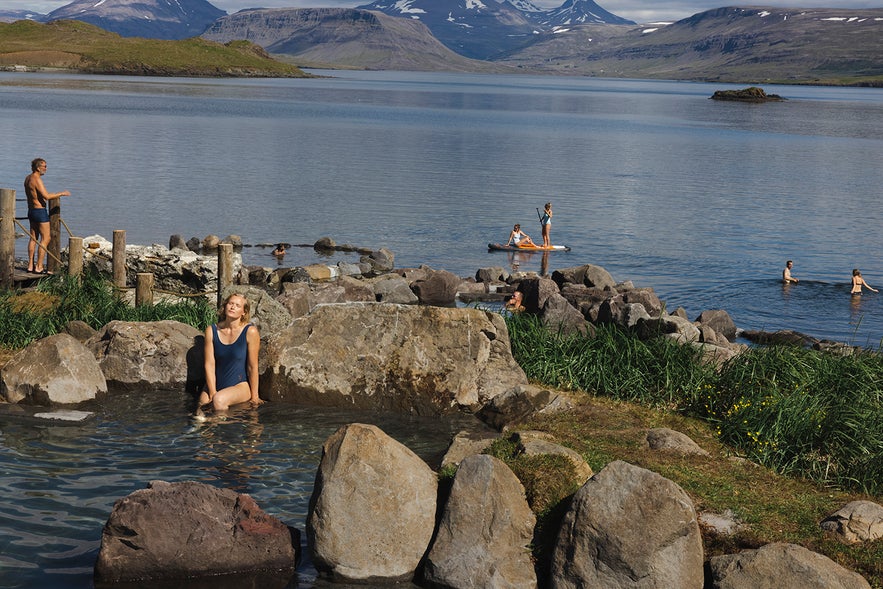 While there, you can engage in various activities if you're so inclined. Hvammsvik offers paddle boards for stand-up paddling in the fjord, regular yoga sessions to join, and an ocean plunge pool for a refreshing dip.
While there, you can engage in various activities if you're so inclined. Hvammsvik offers paddle boards for stand-up paddling in the fjord, regular yoga sessions to join, and an ocean plunge pool for a refreshing dip.
During the winter, the low light pollution and open skies make Hvammsvik a perfect place to see the northern lights while keeping it cozy in a warm geothermal pool. Inside the facility, guests can enjoy food and drinks at the Stormur Bistro and Bar. There is also a swim-up bar in the pool, so you can have some drinks while enjoying the incredible view of the fjord.
Pre-booking is required, so make sure to book admission to Hvammsvik in advance to secure your spot at one of the best hot spring spas in Iceland.
3. Laugaras Lagoon
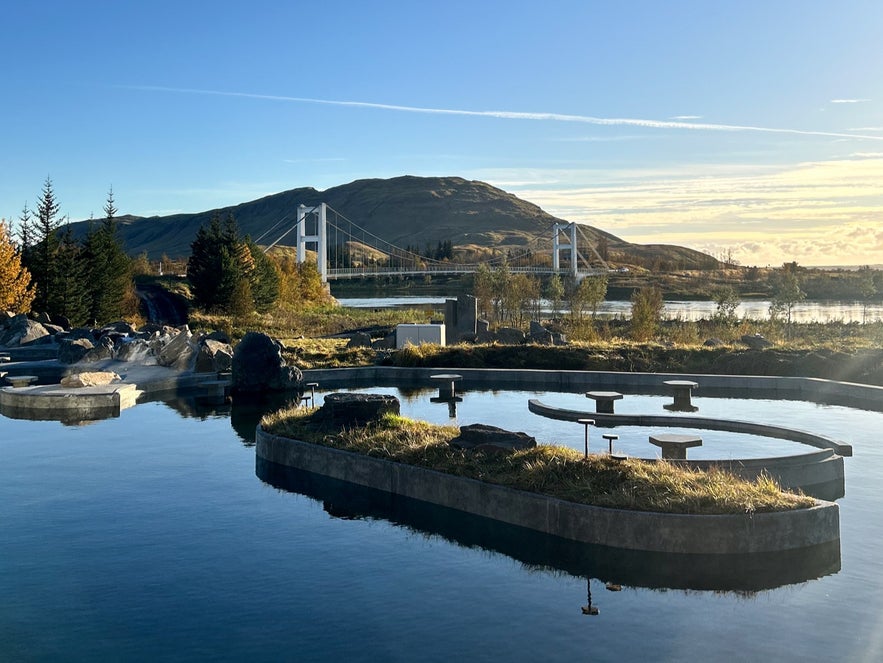 Adding a new dimension of wellness to the Golden Circle, Laugaras Lagoon is one of the latest geothermal spas in Iceland.
Adding a new dimension of wellness to the Golden Circle, Laugaras Lagoon is one of the latest geothermal spas in Iceland.
Found in the village of Laugaras near the town of Selfoss and just over an hour from Reykjavik, it’s designed to blend modern comfort with the beauty of the surrounding nature.
One of the main reasons Laugaras Lagoon is so highly anticipated is its dramatic two-tiered layout, where a waterfall links the upper and lower pools. The soothing geothermal waters stay between 100 F to 104 F (38 C to 40 C), perfect for long, relaxing soaks while taking in river views and wooded scenery.
The lagoon offers several different bathing areas, including a quiet grotto for peaceful escapes, a forest pool tucked among the trees, and a cold plunge pool fed by the nearby Hvita River.
There are also saunas with wide windows overlooking the scenery and swim-up bars where you can enjoy Icelandic drinks without leaving the warm water.
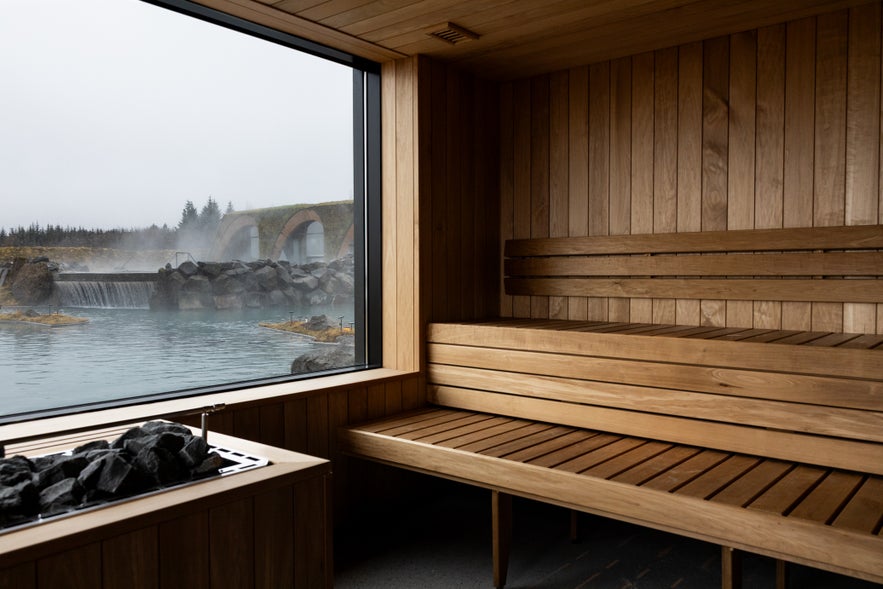 Laugaras Lagoon offers three ticket types. The standard Birki admission includes access to the lagoon’s pools and facilities. For those seeking extra comfort, the premium Lerki admission offers the same access plus a towel and a complimentary drink. The Osp wellness experience features everything from the premium option, along with a two-course meal at the on-site restaurant.
Laugaras Lagoon offers three ticket types. The standard Birki admission includes access to the lagoon’s pools and facilities. For those seeking extra comfort, the premium Lerki admission offers the same access plus a towel and a complimentary drink. The Osp wellness experience features everything from the premium option, along with a two-course meal at the on-site restaurant.
When it’s time to eat, guests can head to Ylja Restaurant, run by celebrated Icelandic chef Gísli Matt. If you’re staying overnight in the area, you’ll also find plenty of Golden Circle hotels nearby, making it easy to combine a visit to Laugaras Lagoon with the region’s waterfalls, geysers, and cultural sites.
2. Sky Lagoon
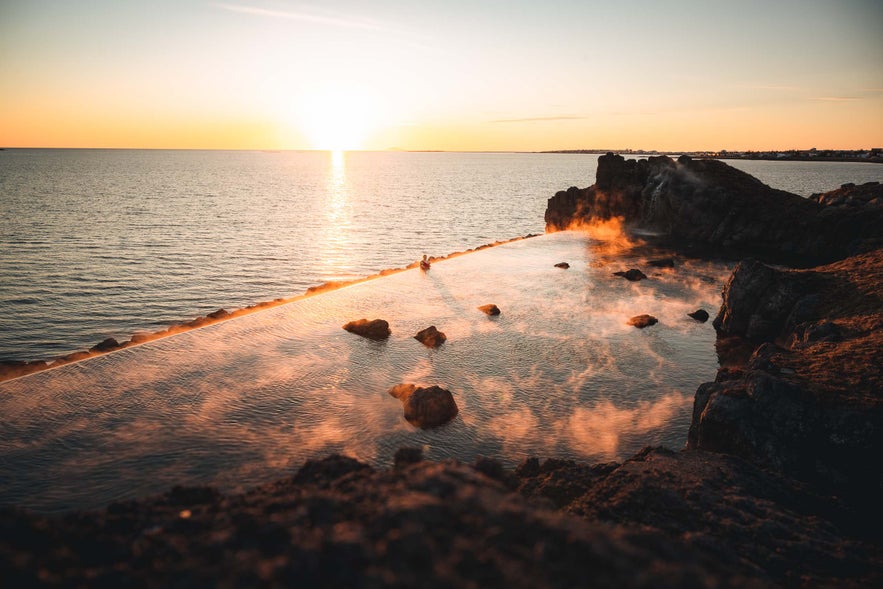 In contrast to the Blue Lagoon, which has been a mainstay in Iceland for decades, Sky Lagoon is fresh on the market and has already become very popular among visitors and locals alike.
In contrast to the Blue Lagoon, which has been a mainstay in Iceland for decades, Sky Lagoon is fresh on the market and has already become very popular among visitors and locals alike.
The geothermal spa opened in 2021 and is located on the edge of the Karsnes Peninsula in Kopavogur, a town on the outskirts of the greater Reykjavik area. Therefore, it's very accessible to those staying in Reykjavik, which is only a 15-minute drive from the city center. It's recommended that you book your Sky Lagoon admission ahead of time, and you can even include a transfer from Reykjavik in your entry ticket.
The most distinct characteristic of the Sky Lagoon is its amazing infinity pool, which overlooks the beautiful Skerjafjordur Bay. This provides incredible views of the midnight sun during the summer and the northern lights during winter.
The lagoon itself is surrounded by large moss-covered cliffs of lava rock, which provide a genuine atmosphere of bathing in a fantastical natural setting, far away from the noise of the city.
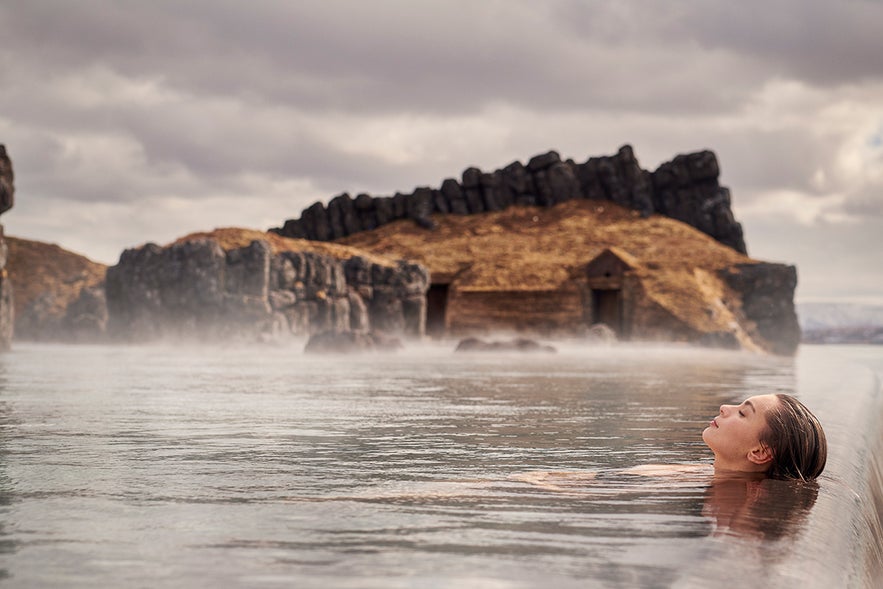 On the premises, you can find a turf house with a cold-water glacial pool, a sauna overlooking the sea, a cold mist room, and a steam room. There is also an in-pool bar that serves alcoholic or non-alcoholic drinks for visitors.
On the premises, you can find a turf house with a cold-water glacial pool, a sauna overlooking the sea, a cold mist room, and a steam room. There is also an in-pool bar that serves alcoholic or non-alcoholic drinks for visitors.
After soaking in the warm geothermal waters for a couple of hours, you might want some hearty nourishment. On-site, you'll find the Sky Cafe, which provides light meals served cafe-style, and Smakk Bar, which offers taste plates of unique Icelandic food and drink.
During your visit, you’ll also discover that Sky Lagoon has its own skincare line. Many of these products are available to try as part of the experience, adding an extra touch of indulgence to your visit. One of the highlights is the Sky Lagoon body scrub, which you can also purchase on-site.
1. The Blue Lagoon
The Blue Lagoon is the most well-known and famous hot spring in Iceland by far. It's even been named one of “The Top 25 Wonders of the World” by National Geographic.
The light blue, milky waters of the lagoon have a perfect temperature of 110 F to 102 F (38 C to 39 C). Although the water is entirely natural and contains rich minerals such as silica and algae, the lagoon didn't form naturally. It was created in 1976 by excess water from a nearby geothermal power plant.
It wasn't until 1981 that the first person tried bathing in it, and ever since then, its soothing qualities and healing waters have only increased in popularity.
Today, the Blue Lagoon is world-famous and definitely the most impressive spa resort in Iceland. It features several restaurants, cafes, an in-water bar, a hotel, a gift shop, and a relaxing area with massage facilities.
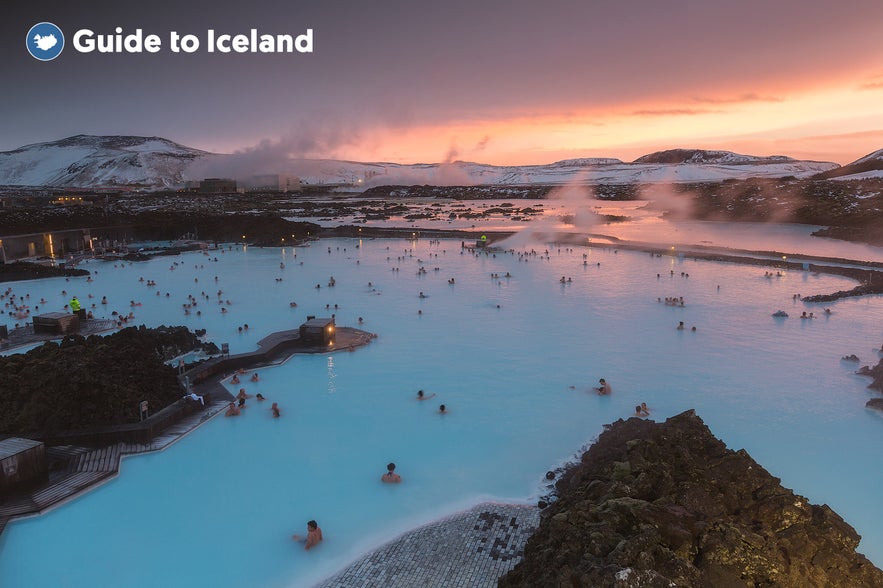
For those looking for the full experience, you can book a Blue Lagoon Premium ticket for added comfort and exclusive perks.
The lagoon continues to expand in size, but entry is limited, so it never feels overcrowded even when fully booked. It’s also one of the pricier bathing options in Iceland, but its world-class facilities make it worth every penny. Because of this, it’s best to book your entry well in advance.
The Blue Lagoon is on the Reykjanes Peninsula. It's only 14 miles (23 kilometers) from Keflavik International Airport and 30 miles (49 kilometers) from the capital, making it one of the closest hot springs to Reykjavik and a popular first or last stop for arriving and departing guests.
If you have a short stop in Iceland, you shouldn't miss out on this excellent bathing spot.
If you’re staying in the capital, you can easily book a bus transfer to the Blue Lagoon from Reykjavik for a smooth and convenient trip. For those who prefer to linger a little longer, consider booking accommodation near the Blue Lagoon to enjoy the serene atmosphere and relaxing surroundings even after your soak.
Special Mention: Bjorbodin Beer Spa
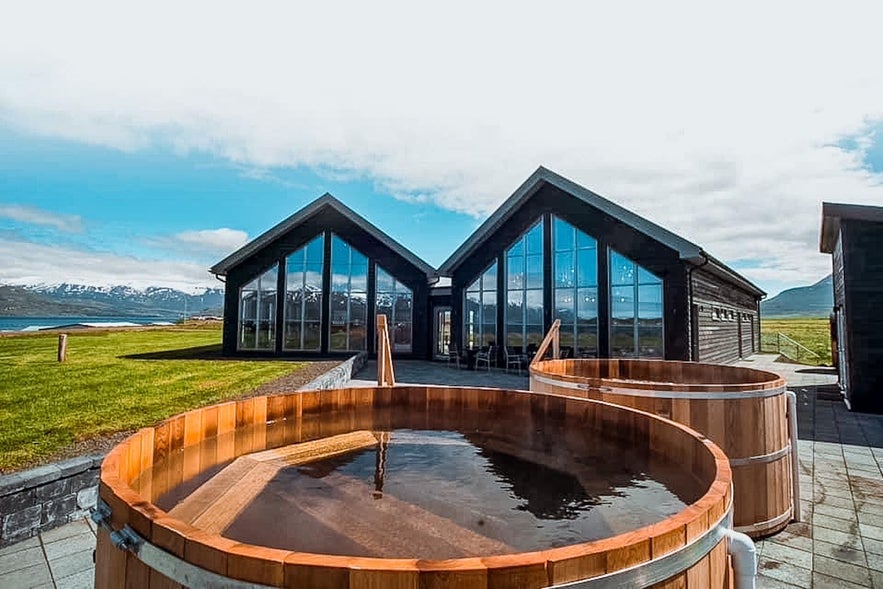
Photo from Bjorbodin Beer Spa.
For a spa with a twist, why not try bathing in beer at the Bjorbodin Beer Spa at the Kaldi Brewery in Arskogssandur in North Iceland?
Here you can enjoy the views of Eyjafjordur Fjord and the island of Hrisey with a cold bottle in your hand, soaking in hoppy, warm beer! The warm beer is said to do wonders for your skin, and after a good soak, you tuck in at a relaxation area.
The beer is at its early fermentation stage when you bathe in it, so it has a very low pH level, which is said to tighten and soften your hair follicles and cleanse your skin. Afterward, you will feel very soothed and relaxed, and it's recommended not to shower 3-5 hours after the bath to allow the body to revitalize.
This spa is the odd one out on the list as it's not a sprawling facility located in a natural environment under the sky. But what it lacks in scale, it makes up for in uniqueness.
You can book your entry to the Beer Spa and plan for a unique soak you'll not soon forget!
Top 5 Best Geothermal Pools in Iceland
 Photo by Regína Hrönn Ragnarsdóttir
Photo by Regína Hrönn Ragnarsdóttir
Besides all the human-made, concrete swimming pools with showers and bathroom facilities you can find around Iceland (some of which are truly spectacular, such as the infinity pool at Hofsos), several are a cross between a human-made pool and a geothermal hot spring.
The water might be all-natural, but someone needed to pile up some rocks or make a concrete structure around it for people to enjoy the place as a bathing location.
To reach these places, you need to rent a car in Iceland as these are often in rural locations, a little hard to get to, and may or may not offer some changing facilities.
5. Hljomskalagardur Wading Pool
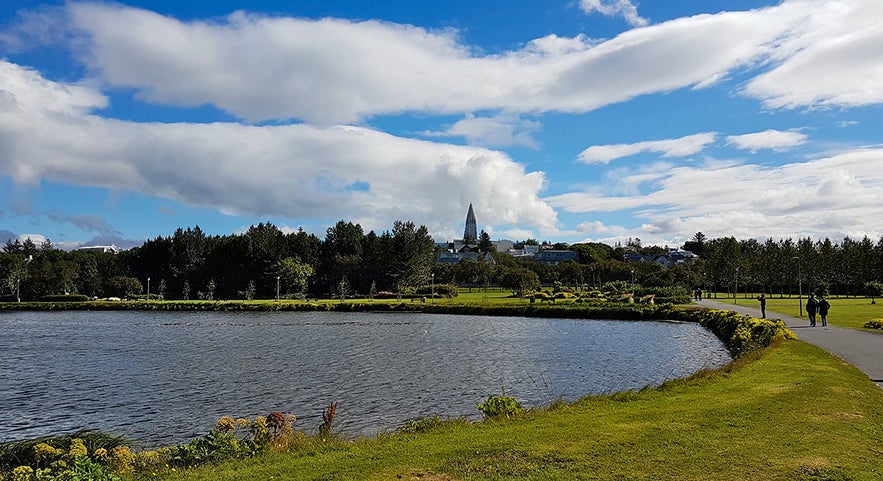
Photo by Jan Ainali, from Wikimedia Creative Commons. No edits made.
Hljomskalagardur Wading Pool in Iceland stands out from the rest of the best geothermal pools in Iceland because it’s not hidden in some remote area in the countryside but right in the heart of Reykjavik's city center.
Located in Hljomskalagardur Public Park, right by Lake Tjornin, this shallow pool is only about a foot deep (30 cm). That makes it perfect for a nice foot bath for adults or for kids to splash around on a warm sunny day.
How this pool came about is an interesting case of direct democracy. The pool was constructed after an open referendum was held on the Reykjavik City Hall's website in 2016, where citizens could vote on what city projects they most wanted to see constructed in their city. The wading pool got the most votes and, therefore, was built the following year.
Hljomskalagardur has become popular among families with young children during the summer, as it's easily accessible and conveniently located. During the winter, the water of the pool is emptied out.
4. Hreppslaug
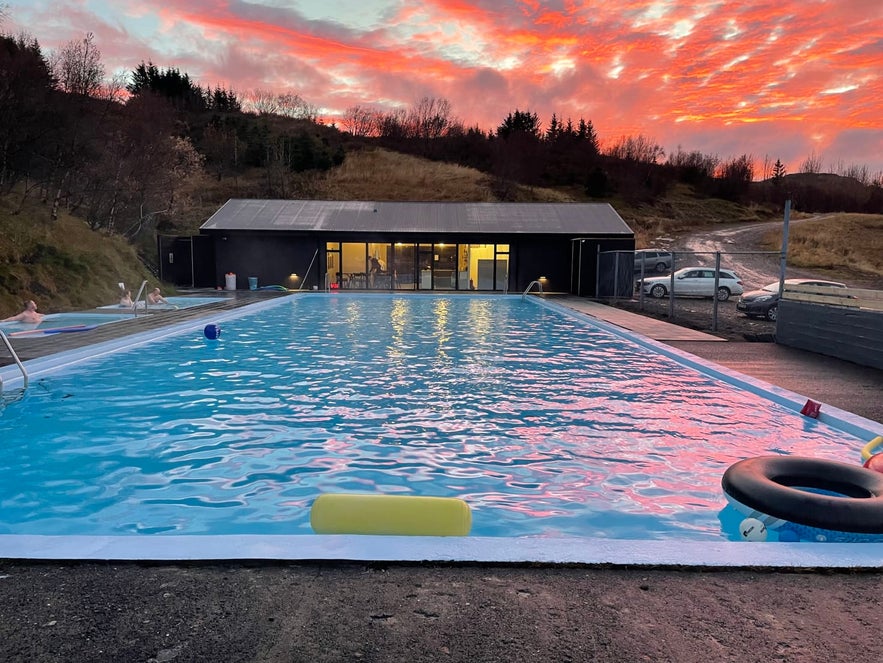
This historic pool is protected by the Cultural Heritage Agency of Iceland, and efforts have been made to preserve its original design and function.
In the summer of 2022, the President of Iceland, Gudni Th. Jóhannesson, visited Hreppslaug to ceremonially open the newly built facilities at the pool, including a new reception area, changing rooms, and showers. There are also two hot pots in the area, which have been newly renovated, and a snack bar.
This is an example of a real countryside pool that is run by volunteers and has a certain authentic charm that larger-scale luxury spas can't compete with.
3. Krossneslaug
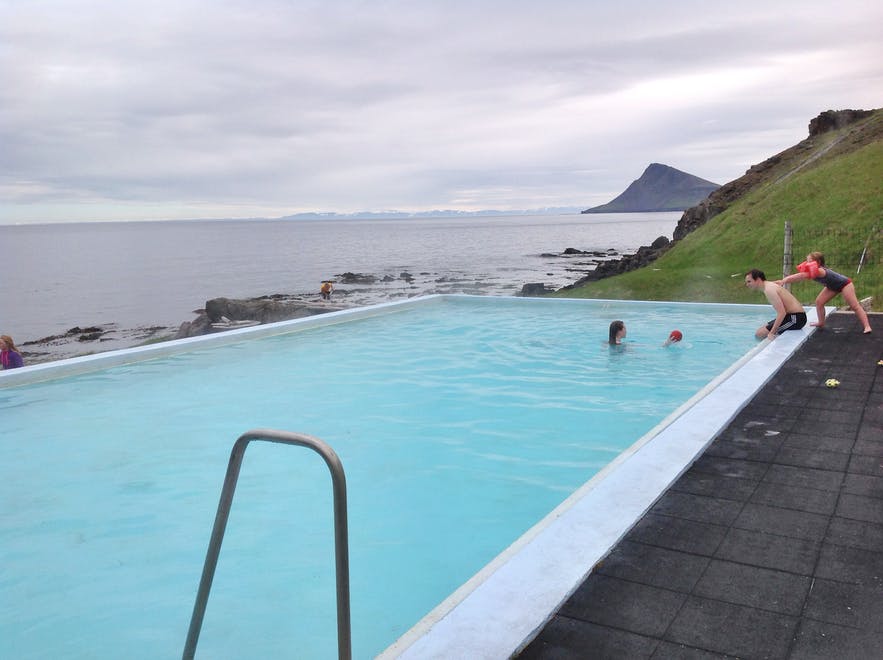 Photo by Alda Sigmundsdóttir
Photo by Alda Sigmundsdóttir
Krossneslaug is one of the most remote yet breathtaking spots among the best geothermal pools in Iceland. Located at the very end of Road 643 on the eastern coast of the Westfjords, this scenic pool offers a truly off-the-beaten-path experience.
Warm water from Icelandic hot springs in the nearby mountains flows into the pool, and there's also a slightly warmer hot tub to the side of it.
The facilities are simple, featuring basic changing and shower rooms. An honesty bucket is provided where visitors can leave a 500 ISK (about 3.50 USD) donation to help keep the area maintained.
Despite the long drive on a gravel road to Krossneslaug, visitors agree that the effort is worth it. The pool overlooks the ocean, offering incredible views and a tranquil sense of isolation.
2. Seljavallalaug
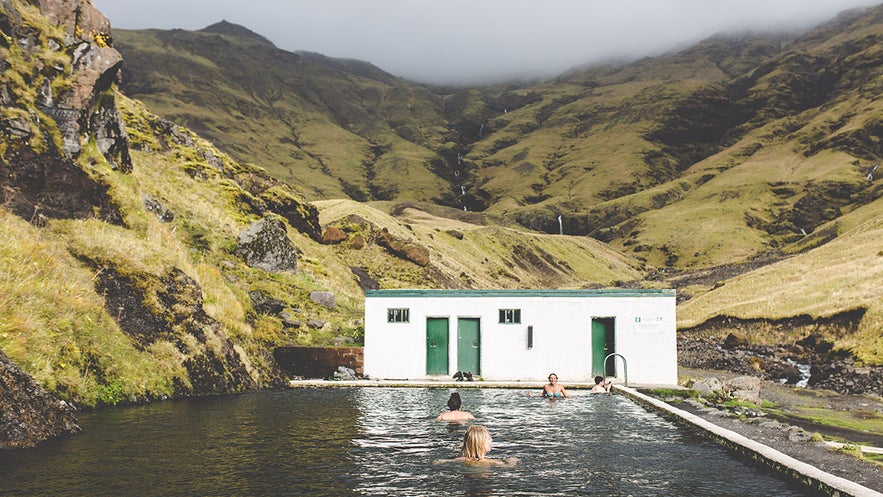 Photo by Tim Wright, from Wikimedia, Creative Commons. No edits made.
Photo by Tim Wright, from Wikimedia, Creative Commons. No edits made.
Seljavallalaug is one of the most unique and historic among the best geothermal pools in Iceland. It’s located on the South Coast between the famous waterfalls Seljalandsfoss and Skogafoss.
Although this is a man-made pool built in 1923, measuring 82 feet (25 meters) long and 33 feet (10 meters) wide, its remote surroundings make it feel completely natural. The geothermal water that trickles into the pool comes directly from the ground, and the pool itself is built into a mountainside that acts as its fourth wall.
The water temperature varies by season. It’s only lukewarm in winter but pleasantly warm during summer, making it a rewarding stop for travelers exploring Iceland’s South Coast.
Keep in mind that the water is cleaned just once every summer, so it can appear a bit murky at times. Still, the peaceful surroundings and raw beauty of the area make the experience special, almost like taking a natural Icelandic mud bath.
Seljavallalaug has two small rooms where visitors can change and leave their clothes. Please keep these clean and tidy, as volunteers only maintain them occasionally.
In 2010, the pool was buried in ash following the eruption in the Eyjafjallajokull Glacier, but a group of volunteers worked tirelessly to restore it to its original state.
Seljavallalaug is 93 miles (150 kilometers) from Reykjavik. To get there, head south on the main Ring Road, past Selfoss and Hvolsvollur. Before reaching Skogafoss, turn left towards 'Seljavellir' on a dirt road. Then, continue on foot for about 10–15 minutes along a scenic mountain path to find one of the best geothermal pools in Iceland, hidden in nature.
1. Secret Lagoon
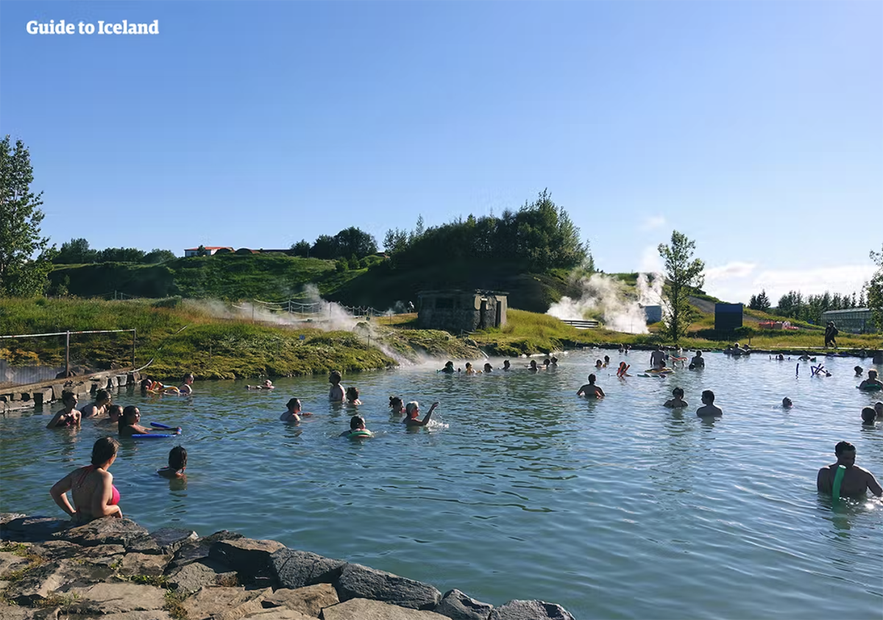
It lay abandoned for decades and fell into disrepair, but it was renovated and reopened in 2014 with brand new facilities, including showers and a bistro that serves light meals and drinks. The pool is a comfortable 100 F to 104 F (38 C to 40 C), making it feel like a large hot tub.
Conveniently located near the Golden Circle, it’s a great stop before or after exploring this popular sightseeing route. You can even enjoy both during this Golden Circle and Secret Lagoon hot spring tour for the perfect balance of adventure and relaxation.
Aside from being a fantastic spot to take a dip, the scenery surrounding the Secret Lagoon is well worth the visit. Right next to it are bubbling hot springs, steaming fumaroles, and even a small geyser that erupts every few minutes.
Make sure to book your Secret Lagoon admission in advance to secure your spot at one of the best hot spring spas in Iceland.
Top 5 Free Natural Hot Springs in Iceland
Wondering where to find the best hot springs in Iceland that won’t cost you a thing? You’re in luck, as several incredible geothermal spots across the country are completely free to enjoy.
Here are five of the most beautiful natural hot springs in Iceland, each offering a unique experience. Some are easy to reach, while others require a bit of an adventure, but all are worth it.
You can visit these hot springs on your own by renting a car or joining a hot spring tour that takes you straight to nature’s geothermal treasures.
5. Viti in Askja
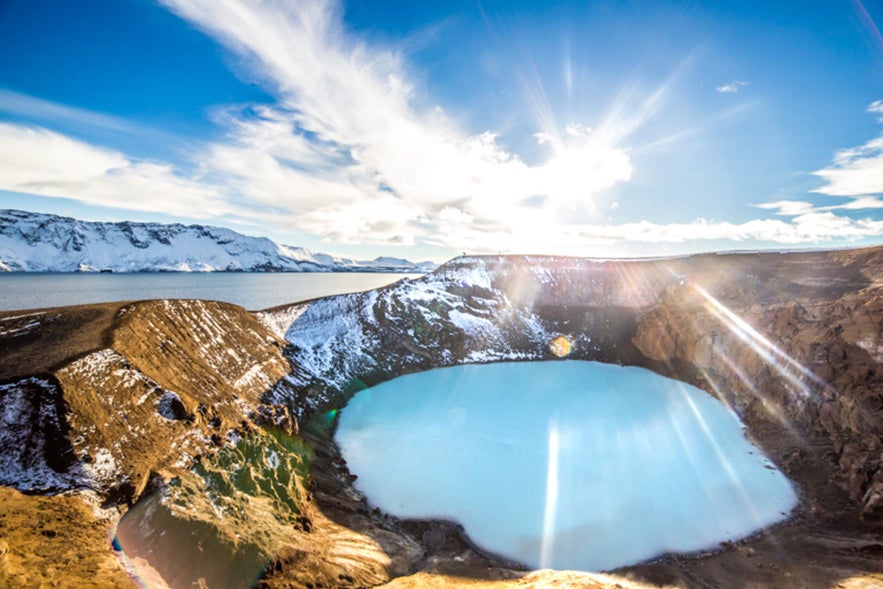
Also located in East Iceland and not far from Laugavallalaug, the Viti Crater in Askja is one of the country’s most unique geothermal spots. It’s not to be confused with the Viti Crater in Krafla, as this one sits deep in the remote Highlands and offers a completely different experience.
The name “Víti,” meaning “hell,” comes from the massive volcanic eruption in 1875 that created it and devastated the surrounding area. Today, it’s one of the most remarkable free hot springs in Iceland, where you can soak in warm, milky-blue water inside a volcanic crater surrounded by dramatic highland scenery.
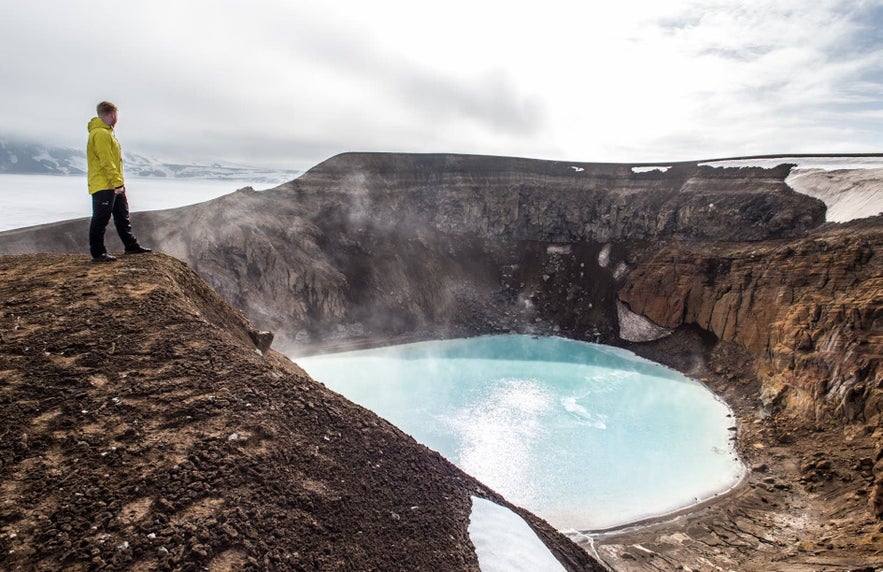
The water temperature in Viti is around 85 F (30 C) but can be scalding hot in the eastern part of the crater. Always test the water before entering, and be cautious about where you submerge yourself in the crater.
The bottom of the crater is muddy, and there's also a high amount of sulfur in the water, creating steam that can cause people to faint.
But the place has been described as one of the most magnificent spots in Iceland. You can visit this incredible geothermal site by joining one of the Askja and Viti Crater tours that explore the otherworldly landscapes of the Highlands.
4. Laugavallalaug
Here, you'll find not just a natural hot spring to bathe in but a natural hot waterfall as well! Laugavallalaug is situated high in the eastern highlands, so this natural pool is more challenging to reach than others.
You'll need a sturdy car to get near it as you need to drive up a 4.2-mile (7-kilometer) F-road that's only passable for four-wheel-drive vehicles. Then, there's a short 600-foot (200-meter) walk to reach the pool.
Alternatively, you can drive a two-wheel-drive car to Karahnjukar Dam, then hike alongside Hafrahvammar Canyon to the warm waterfall. The hike takes around seven hours (with time for bathing included).
There are also two very nice natural pools, with a circular stone wall at the highland cabin Laugarfell, which isn't too far away and is easier to reach. It's the perfect place to spend the night when exploring the area.
Super Jeep tours and hiking tours operate from here or from the nearby town of Egilsstadir, offering travelers another way to experience one of the best free hot springs in Iceland.
3. Landmannalaugar
Photo by Julien Carnot, from Wikimedia Commons. No edits made.
Landmannalaugar is an area in the Icelandic Highlands known for its stunning multi-colored landscape and popular hiking destination. You'll see sandy mountains in red, blue, green, yellow, purple, and black everywhere you look.
After an exhausting day of hiking, the best thing to do is to relax in the hot geothermal pools that are waiting for you next to the campsite. The thermal pools stay consistently warm throughout the summer and have a steady stream of hikers relaxing in them. It's the perfect oasis in the highlands.
Take note that some parasites have been found in these pools in the past, but they're considered harmless. However, if you are allergic to mosquito bites, you should abstain from entering the pools.
Landmannalaugar is only accessible during the summertime and only with a four-wheel-drive vehicle. You'll need to cross some rivers to get there, so if you're not used to driving in the highlands, you may want to take a bus or go on a super jeep tour to Landmannalaugar.
If you prefer to drive yourself on a summer self-drive tour, go carefully and make sure you cross rivers where they're at their widest (as they're deeper and run faster where they're narrow). Ask other drivers you meet where it's best to cross, as the rivers are constantly changing.
If you're short of time, Landmannalaugar can even be explored in a day. It’s one of the best free hot springs in Iceland, offering an unforgettable soak surrounded by some of the country’s most colorful and dramatic landscapes.
2. Hellulaug
Photo by Regína Hrönn Ragnarsdóttir.
You can find Hellulaug in the Westfjords, just about 550 yards (500 meters) east of Hotel Flokalundur.
If you are crossing Breidafjordur Fjord with the Baldur ferry, perhaps making a stop at Flatey Island, this natural hot pool is only 3 miles (5 kilometers) from Brjanslaekur, where the ferry docks.
The pool is not seen from the road, but is right next to it, filled with naturally heated water at around 100°F (38°C). It’s about 24 inches (60 centimeters) deep, making it perfect for a relaxing soak while taking in the coastal scenery. If you get too warm, you can cool off in the nearby sea.
There are no changing rooms, showers, or bathrooms in the area, keeping the spot wonderfully wild and authentic and offering one of the best free hot spring experiences in Iceland.
1. Reykjadalur: An Icelandic Hot Spring Thermal River

Reykjadalur (which translates to "Steam Valley") is one of the most accessible hot spring areas to reach from Reykjavik. It’s also one of the best free hot springs in Iceland, perfect for travelers who want a natural soak surrounded by untouched landscapes.
The nearby town of Hveragerd, located about 28 miles (45 kilometers) away, serves as the starting point for the scenic hike up to the warm river that flows through the Reykjadalur Valley.
The hike is not very demanding, although it's mostly uphill. The path is not recommended for people who are afraid of heights since you'll be hiking along the top of a deep gorge at one point.

If you are in good shape and don't make many stops along the way, you should reach the thermal river after 45-60 minutes. However, the hike could take up to 90 minutes one way.
The duration depends on how fast you walk and how often you stop to take pictures of the waterfall in the gorge and all the pretty bubbling muddy hot springs on the way.
There are no facilities for changing your clothes when you get up there. Still, bathing in the open air under Iceland’s vast sky makes this one of the most authentic and best hot springs experiences in Iceland.
You can reach the river on this Reykjadalur hot spring hiking tour, a fantastic way to experience one of Iceland’s most scenic geothermal areas.
Top 5 Best Hot Tubs in Iceland
 Photo by Regína Hrönn Ragnarsdóttir
Photo by Regína Hrönn Ragnarsdóttir
You've read about the thermal pools in Iceland, but there are also hundreds of scenic hot tubs in Iceland.
Each public swimming pool in Iceland boasts at least one hot tub. There can be up to six or seven hot tubs in some cases, and they're also common in private residences and hotels.
If you'd like a private hot tub, then consider renting a remote summer cabin. A large percentage of Icelandic summer cabins come with a hot tub.
The following list contains the best human-made tubs to visit in Iceland. They're in spectacular settings, often with views of impressive mountains or the enchanting sea.
5. Kvika Foot Bath
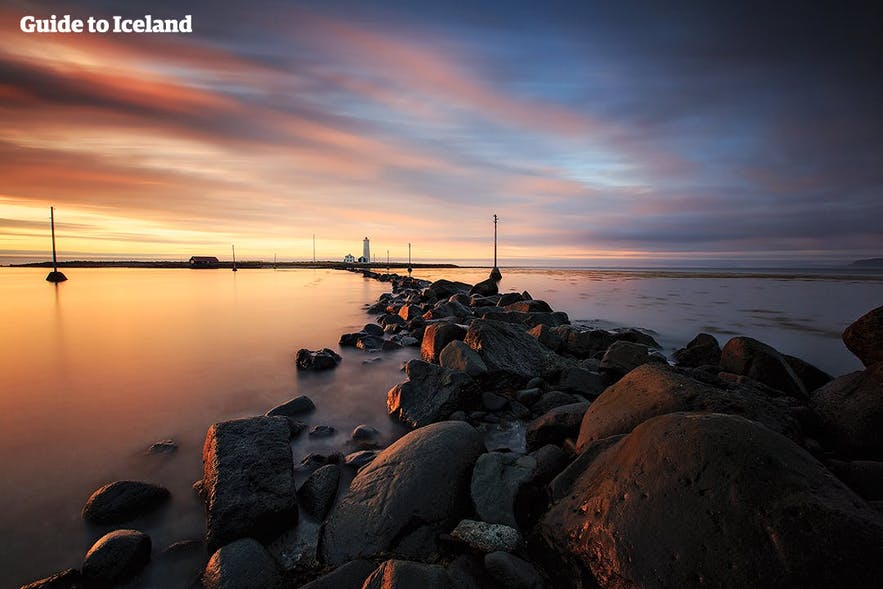
Found near the Grotta Lighthouse in the greater Reykjavik area, the Kvika footbath is one of the most unique and relaxing spots among the best hot tubs in Iceland…though this one is just for your feet!
Artist Olof Nordal designed this human-made hot spring, and it sports one of the best views in town, looking over Mountain Esja and the mighty Snaefellsjokull Glacier.
Olof carved a small bathing pool, about 30-35 inches (80-90 centimeters) wide and 10-12 inches (25-30 centimeters) deep, into a large rock.
The constant trickle of warm water comes from a nearby borehole and is cooled down to around 102 F (39 C).
Both Kvika and the Grotta Lighthouse are popular locations for locals to watch the sunset or the northern lights. Enjoying the view here is one of the top things to do in Reykjavik.
Keep in mind there are no changing facilities, as Kvika is only meant for foot soaking. Entry is free, and the experience is pure Reykjavík charm.
4. Hoffell Hot Tubs
There aren't many famous hot springs in East Iceland, but the Hoffell hot tubs are definitely among the best hot tubs in Iceland for those looking to unwind in a peaceful, natural setting.
There are four different hot tubs located right next to each other. Each tub is neatly set in a bed of rocks, with spectacular views of the surrounding snow-capped mountains.
There's a small entry fee, but those staying at the nearby Glacier World accommodations can take a dip for free.
The Hoffell hot tubs are situated 12.5 miles (20 kilometers) west of the town of Hofn in East Iceland. To get there, turn from the Ring Road onto Road 984 towards Glacier World Guesthouse.
3. Nautholsvik
 Photo from Wikimedia, Creative Commons, by Helgi Halldórsson. No edits were made.
Photo from Wikimedia, Creative Commons, by Helgi Halldórsson. No edits were made.
Besides the numerous swimming pools and hot tubs you can find within the capital region, there's also the city's geothermal-heated beach, Nautholsvik.
Visiting Nautholsvik is another fantastic budget activity to check off in Reykjavik. Here, you'll find both a hot tub at the edge of the seawater, as well as a broader but shallower warm pool by the changing facilities.
Next to the changing facilities are bathrooms, showers, a sauna, and a small cafe.
The water in the hot tub by the sea varies in temperature, from 86 F to 102 F (30 C to 39 C), but the shallower pool is a constant 100 F (38 C).
Even the sea right by the beach is heated during the summer months and is about 59 F to 66 F (15 C to 19 C) within the rock fence.
Entry is free throughout the summer months. In winter, the opening times are shorter, and a small fee applies to the changing facilities.
2. Gudrunarlaug
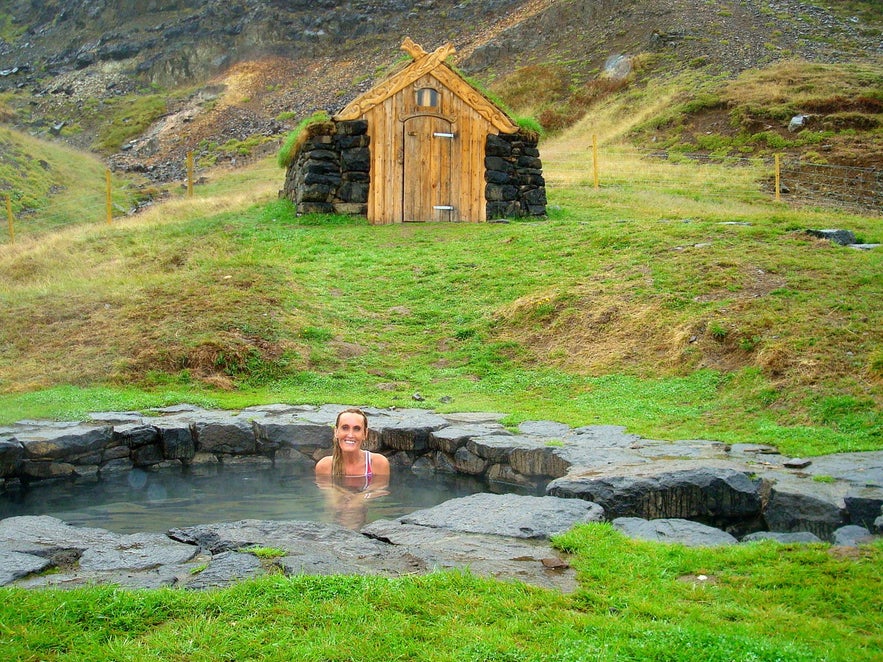
Gudrunarlaug is one of the best hot tubs in Iceland for travelers interested in history and legend. Named after Guðrún Ósvífursdóttir, one of the most remarkable women from the Icelandic Sagas, this reconstructed historical pool offers a glimpse into how people bathed during the settlement era.
These thermal baths in Iceland have existed for over a thousand years, but were blocked by a landslide for 140 years. The pool was reconstructed and built as a replica of the original pool and was opened in 2009.
Gudrunarlaug is in West Iceland, on the way to the Westfjords. Nearby to the pool is Hotel Laugar Saelingsdal and the Laugar campsite. You can also visit the Church of the Elves, which is located close to the pool, and have yourself a full day of Icelandic history and folklore in the West!
To reach it, you have to rent a car as no scheduled buses or tours go there. Head north from Reykjavik on the Ring Road, turn onto Road 60 towards the Westfjords, and go left onto Road 589 until you reach the hot spring.
Entry is free, and there's a small changing room on site. To preserve this piece of Icelandic history, please tidy up after yourself and treat the area with respect.
1. Drangsnes Hot Tubs
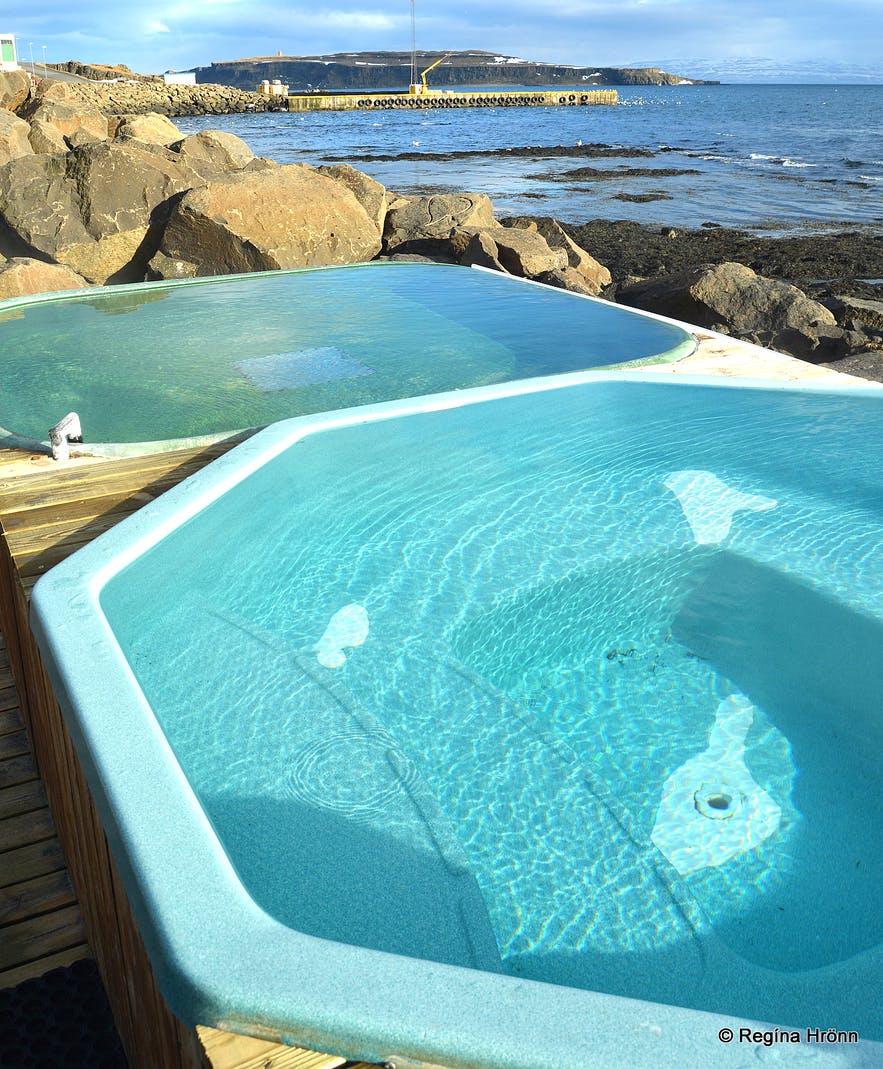 Photo by Regína Hrönn Ragnarsdóttir
Photo by Regína Hrönn Ragnarsdóttir
In the center of the small town of Drangsnes in the Westfjords, you'll find three hot tubs right by the seaside. These tubs have free entry, and you can go there at any time of the day or night.
The temperature varies from one hot tub to the next, but they're between 100 F to 107 F (38 C to 42 C). Across the road, there’s a small changing facility, and it’s common to meet some friendly locals once you get into the tubs.
If you’re feeling brave, take a quick dip in the icy sea nearby before returning to the warmth. It’s an invigorating Icelandic experience and one reason Drangsnes is often listed among the top geothermal hot tubs in Iceland.
Top 5 'No Bathing' Hot Springs & Pools in Iceland
If you are unfamiliar with hot springs in Iceland, it may be hard to tell the difference between those that are safe to enter and those that are not if there are no warning signs.
There are plenty of hot springs, pools, hot tubs, and geysers in Iceland, both natural and human-made, that you should not attempt to bathe in.
Most of the time, this is because it's simply too dangerous, either because the water is too hot, too unstable, or too cold. It should go without saying that any hot spring with large boiling bubbles is too hot to enter.
These hot springs are fenced off in the most famous geothermal areas and will have a warning sign telling you to be careful. However, that may not be the case with all hot springs in Iceland.
5. Brimketill
Brimketill is a natural feature that looks ideal for bathing, and some daredevils have entered its waters, as seen in the video above. This clip was shot years ago (on a very calm and sunny day) before a ban on bathing was enacted due to this natural pool's hazardous surroundings.
Brimketill is not a hot spring, and its waters are far from being on the warm side. The Atlantic Sea is all you'll get here, which is cold enough to give people hypothermia if they stay in for too long.
Its name means 'Whitewater Cauldron,' due to the constant white rolling of the waves breaking on the surrounding rocks. The sight is impressive to see from a safe distance.
On a beautiful, sunny day, the water may look appealing, but this area has strong winds, with towering waves crashing on the rocks most of the time. The seawater also continually sprays the slippery rocks, making Brimketill a dangerous place to stand or risk a fall.
You can reach Brimketill by driving along the Reykjanes Peninsula or joining Reykjanes tours that include stops at this dramatic seaside lava pool.
4. Blahver
Blahver may look like the perfect spring for a soak, with its mesmerizing blue water and calm surface showing little sign of geothermal activity. You might be tempted to imagine yourself relaxing in its azure waters, but this hot spring hides deadly dangers.
The water in Blahver is scalding hot, and entering it would cause severe burns. Even getting too close is risky, as the edges are thin and fragile and could collapse underfoot, making escape nearly impossible.
Thankfully, Blahver and several nearby springs in the Hveravellir Geothermal Area near Lake Myvatn are fenced off for safety. You can still admire their surreal colors (and distinctive sulfur scent) from a safe distance.
If you’re looking to enjoy a real soak, there’s a small man-made pool nearby filled with naturally heated water from the same geothermal source, safely cooled to the perfect temperature for bathing.
3. Snorralaug
 Reykholt Village in West Iceland is one of the most important historical locations in the country. It's here where the great medieval historian, poet, and lawmaker, Snorri Sturluson, lived.
Reykholt Village in West Iceland is one of the most important historical locations in the country. It's here where the great medieval historian, poet, and lawmaker, Snorri Sturluson, lived.
Snorri is best known for having written the Prose Edda, one of the greatest works of European literature and an invaluable source for our knowledge of Norse mythology.
Just outside of his turf house, he had constructed his very own geothermal pool. The pool is one of Iceland's oldest structures, and since this is a historical location, bathing in the pool is forbidden. The water temperature varies, becoming extremely hot at times, so bathing there could also be dangerous.
Snorralaug Pool is small, only around 13 feet (4 meters) in diameter and 2.2-3 feet (0.7-1 meters) deep. Therefore, it would not handle the swarms of bathers and would quickly become dirty and unappealing for visitors.
However, people don't come here to bathe. They visit the nearby Snorrastofa Museum and learn about history, Norse mythology, and the man who lent his name to the pool, Snorri Sturluson.
2. Grjotagja
 Photo from Wikimedia, Creative Commons, by Chmee2. No edits were made.
Photo from Wikimedia, Creative Commons, by Chmee2. No edits were made.
Made famous worldwide in a steamy scene between Jon Snow and Ygritte from Game of Thrones, Grjotagja may look like the ideal place to take a warm bath. However, that's not the case.
The water temperature in Grjotagja can fluctuate drastically. It became too hot for swimming in the late 1970s (around 122 F or 50 C) and, while it has cooled somewhat since, it can still be dangerously hot depending on recent geothermal activity or earthquakes.
Because of the water's varying heat, loose rocks in the cave, and the extremely slow water flow, bathing here is now strictly forbidden.
Even without a swim, Grjotagja is worth the visit for its incredible natural beauty. The cave’s shimmering blue water against dark lava rock makes it one of the most photogenic spots in North Iceland.
And if you still want a proper soak, head just around the corner to Earth Lagoon Myvatn (formerly Myvatn Nature Baths) for a relaxing dip in safe, geothermal waters.
Grjotagja is easy to reach if you’re staying in Akureyri or exploring the Lake Myvatn area. From the village of Reykjahlid on the Ring Road, drive east for a few kilometers, then turn right just before the road leading to Earth Lagoon Myvatn.
1. Geysir
Although it has remained dormant for a few years, Geysir still contains boiling water far too extreme to enter. The Geysir Geothermal Area has smaller geysers, including the famous Strokkur, which erupts every few minutes.
Several steaming pools and springs look incredibly alluring on a cold winter's day. As Geysir is one of the most frequently visited areas in Iceland, being part of the popular Golden Circle, these hot springs are all fenced off.
When visiting there, you'll find warning signs detailing that they're up to 212 F (100 C) hot.
In the year 2000, Geysir erupted unexpectedly. A large gathering of people that had been standing nearby had to run for their lives, and the water burned several people's feet and legs.
The land surrounding the geysers can also be extremely hot, so you'll be asked to keep to the designated path so your feet do not sink into the burning mud. It's always wise to be careful in any geothermal area you may visit in Iceland.
FAQs About Hot Springs and Lagoons in Iceland
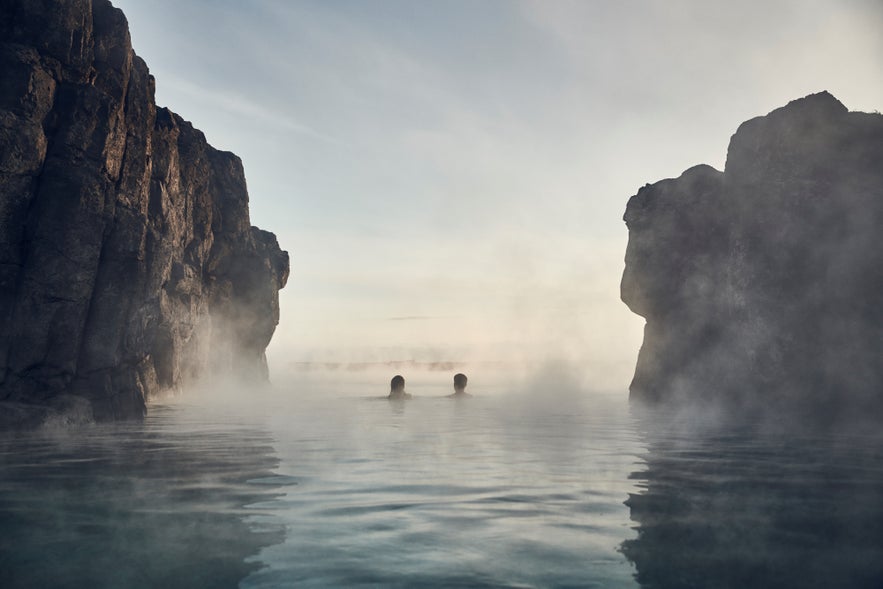
Here are some of the most common questions travelers have about hot springs and lagoons in Iceland.
What are the benefits of soaking in a hot spring?
Hot springs in Iceland are popular for their relaxing and rejuvenating qualities. Soaking in these geothermal pools can improve blood circulation, relieve joint and muscle pain, and soothe skin conditions like psoriasis and eczema due to the silica and minerals in the water. While these benefits are widely appreciated, it’s always a good idea to consult your doctor if you have specific health concerns before visiting a hot spring.
Are there any hot spring resorts in Iceland?
Yes, Iceland has hot spring resorts where you can enjoy a luxurious geothermal experience. Examples include Krauma Geothermal Bath Resort, where you can soak in natural hot springs surrounded by stunning landscapes, and Kerlingarfjoll Mountain Resort, offering overnight stays with on-site hot tubs, perfect for catching the northern lights. For those seeking comfort and relaxation, these resorts provide the ideal hot spring escape.
What are lagoons in Iceland?
Lagoons are bodies of water separated from a larger water source by a natural landform, such as a reef or peninsula. The best lagoons in Iceland include the Blue Lagoon, which is located on the Reykjanes Peninsula and is Iceland’s most iconic geothermal spa. Another one is the Sky Lagoon, which is located just outside Reykjavik. It has quickly become a favorite for its serene setting and stunning views. These lagoons offer a unique and concentrated hot spring experience, combining relaxation with the beauty of Iceland’s landscapes.
Why are hot springs popular in Iceland?
Hot springs are a cornerstone of Icelandic culture, offering relaxation, natural beauty, and health benefits. The mineral-rich waters can help with conditions like eczema, improve circulation, and soothe sore muscles. Hot springs also allow visitors to enjoy Iceland’s unique volcanic landscapes year-round.
How are hot springs formed in Iceland?
Iceland’s location on the Mid-Atlantic Ridge creates a mix of geothermal activity and Arctic landscapes. This combination results in the formation of numerous hot springs, geothermal pools, and spas, each with distinct features.
What are Iceland's geothermal pools and spas like?
Geothermal pools in Iceland combine natural beauty with modern facilities. They often include amenities like saunas, restaurants, and bars. Some popular spas, like the Blue Lagoon and Sky Lagoon, also feature infinity pools and skincare treatments.
Can you bathe in all Icelandic hot springs?
Not all hot springs are suitable for bathing. Some, like Geysir or Blahver, are too hot or unstable. Always follow safety guidelines and stick to designated bathing areas.
What’s the difference between a hot spring and a lagoon?
Hot springs are natural geothermal pools, while lagoons are often man-made or enhanced for comfort. Both offer warm, relaxing waters, but lagoons, like the Blue Lagoon, often have additional facilities such as spas and cafes.
Are hot springs accessible year-round?
Yes, most hot springs in Iceland can be enjoyed in any season. From soaking under the midnight sun in summer to relaxing beneath the northern lights in winter, hot springs offer unforgettable experiences year-round.
Your Ultimate Iceland Hot Springs Experience Awaits
Iceland’s hot springs and geothermal pools are more than just places to soak; they’re windows into the country’s volcanic soul. From the iconic Blue Lagoon and Sky Lagoon to hidden gems like Viti Crater and Seljavallalaug, each geothermal pool offers a relaxing and breathtaking experience.
Warm mineral-rich waters, rugged landscapes, and serene surroundings make every dip unforgettable. Travelers can explore both luxury spa resorts and free natural hot springs, discovering Iceland’s best hot spring spas.
With hot spring tours in Iceland scattered across the Highlands, the Eastfjords, Westfjords, and near Reykjavik, your geothermal journey promises both peace and awe. You can also experience the country’s untouched wilderness up close on self-drive adventures in Iceland.
Which hot spring captures your heart? Are there any favorite Icelandic bathing spots we missed? Which geothermal spa are you most excited to soak in? We’d love to know your thoughts and experiences in the comments below!

